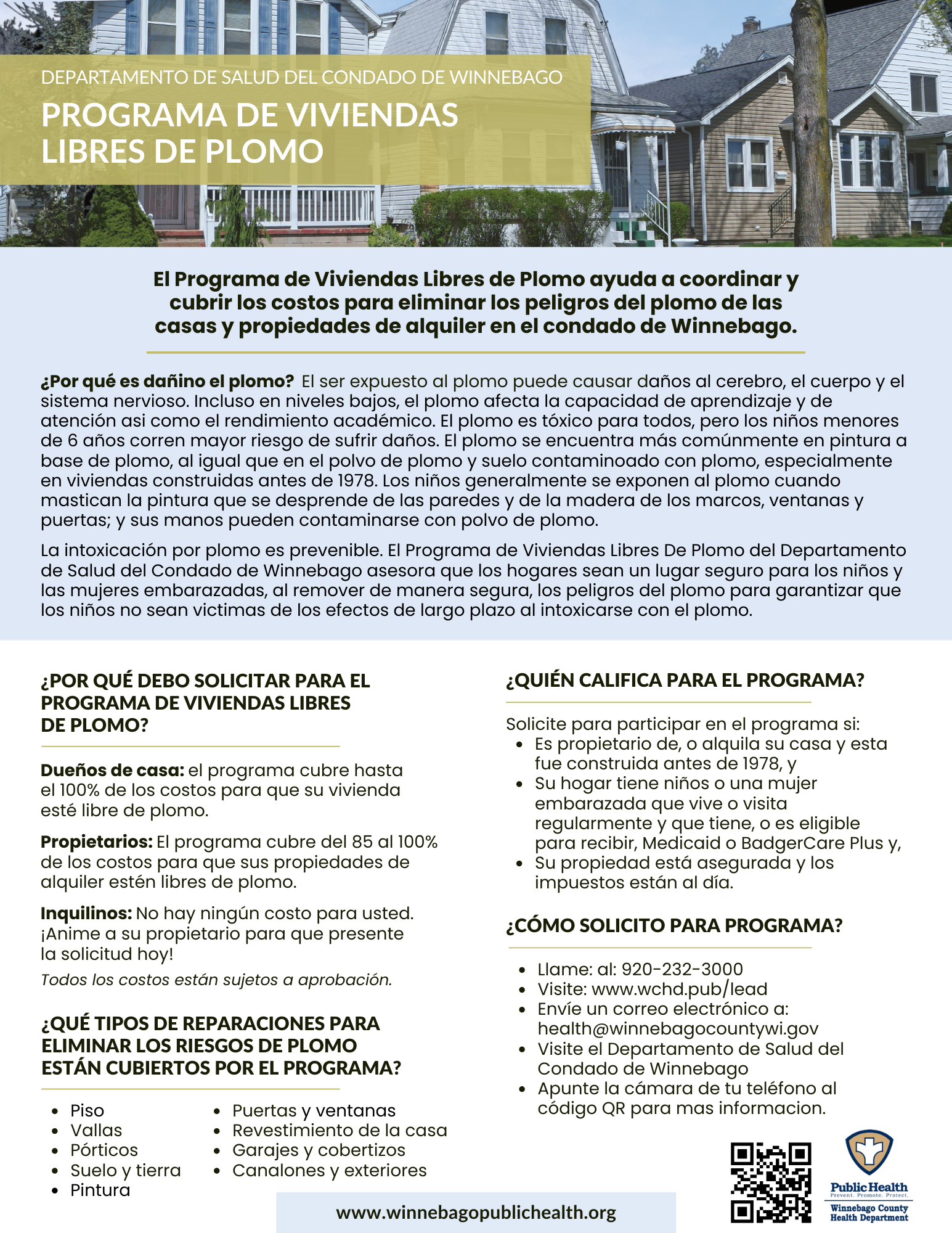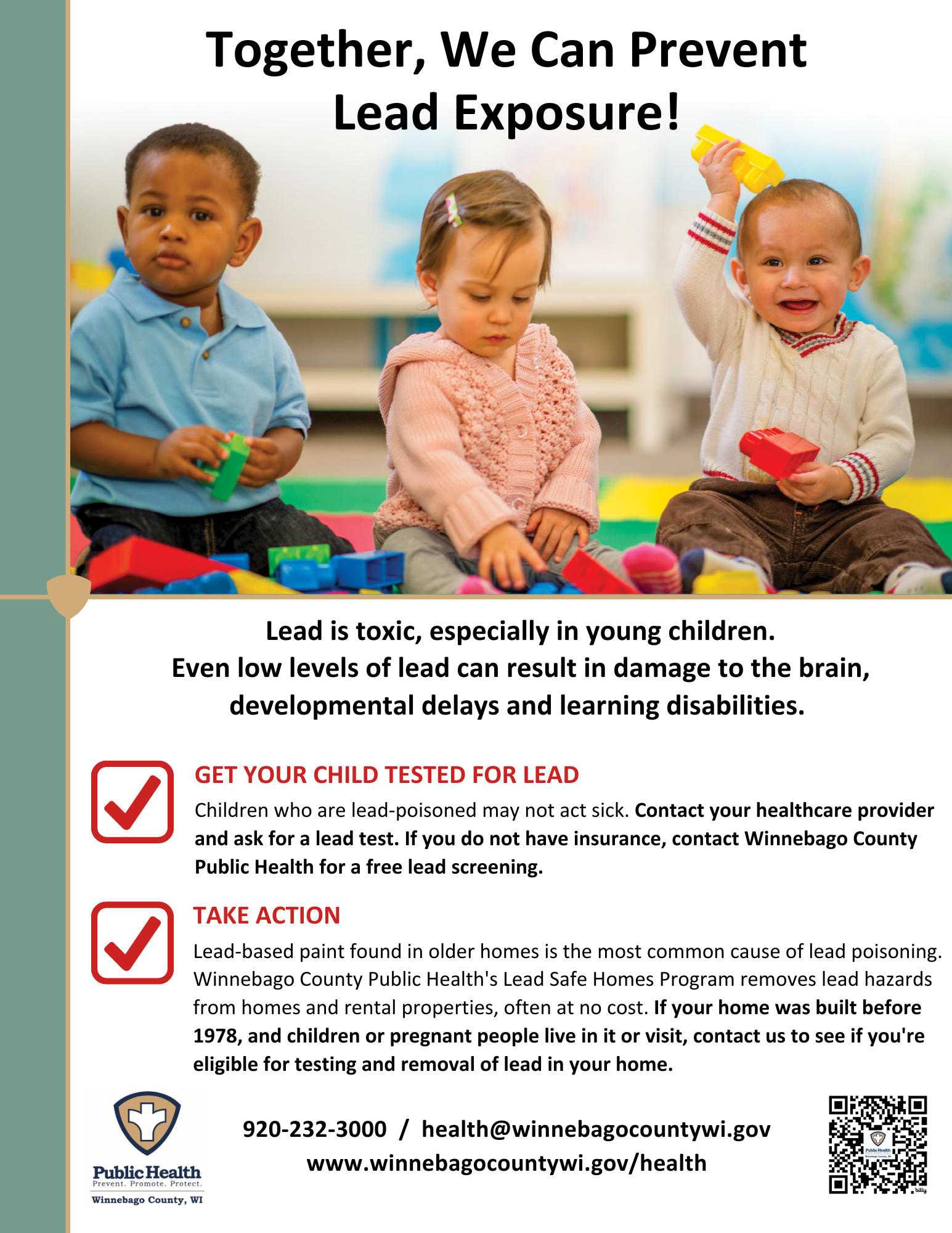Lead, a naturally occurring metal, is abundantly found throughout the Earth. It has been used in a wide variety of products including gasoline, paint, plumbing pipes, ceramics, solders, batteries, and even cosmetics. Because it is so unsafe, the US banned lead from being used in paint in 1978.
Lead Safe Homes Program
Winnebago County Public Health Lead-Safe Homes Program helps keep kids safe from the dangers of lead poisoning by providing the safe removal of lead from qualified homes and rental properties.
What homes and rental properties are eligible for the Lead-Safe Homes Program?
Apply for the program if:
- Children or pregnant women live in or regularly visit the home and are on Medicaid or BadgerCare Plus.
- The home or rental property was built before 1978.
- The property is insured and taxes are up to date.
Why should I apply?
- Homeowners: The program covers up to 100% of the costs to make your home lead-safe.
- Landlords: The program covers between 85 - 100% of the costs to make your rental properties lead-safe.
- Renters: There is no cost to you. Encourage your landlord to apply today!
Costs are subject to approval.
How do I apply for the program?
- If you are a homeowner, complete this application.
- If you are a tenant of a rental property, complete this application.
- If you own a rental property, complete this application.
What to expect (Program Process):

- Application: Necessary paperwork completed before inspection is scheduled.
- Risk Assessment: Home inspected for lead hazards.
- Inspection Results: Findings discussed with owner. Program staff creates work plan.
- Contractor Walk-Thru: Team of contractors visit property to prepare estimates of work.
- Contract Signing: Owner comes in to sign necessary paperwork to begin work.
- Relocation Meeting (If Necessary): Staff meets with tenant to sign paperwork for temporary hotel and meal card if necessary.
- Start of Work: Contractors begin work to remove lead hazards.
- Clearance/Completion: Staff takes dust wipes inside to assure work meets lead-safe standards.
Questions about the Lead Safe Homes Program?
If you have questions about this program or need assistance completing an application, please call Winnebago County Public Health at 920-232-3000 or email health@winnebagocountywi.gov.
Additional Resources:
If you do not qualify for the Lead-Safe Homes Program, but you would like a lead hazard risk assessment, you can find a certified inspector or risk assessor on the United States Environmental Protection Agency's website or call the National Lead Information Center at 1-800-424-LEAD. Ask your landlord to have your home or apartment tested if you rent. To find out if you have lead in your drinking water, contact your water company and ask about testing.
Lead-Safe Homes Contractors:
Contractors certified in lead abatement or lead risk assessment can qualify for reimbursement as part of the Lead Safe Homes Program. Contact the Winnebago County Health Department at 920-232-3000 or health@winnebagocountywi.gov to learn how your work time, supplies, training, mileage, and other lead abatement costs can be reimbursed.
Lead Water Service Lines
Water Service Lines. The cities of Oshkosh and Neenah have interactive maps that allow residents to check the status of their water service lines by address. For other cities and municipalities please contact your water utility provider directly. Private well water can be tested through UW-Oshkosh Environmental Research Innovation Center (ERIC) lab.
Childhood Lead Poisoning Prevention
Lead poisoning can affect anyone, but babies and children under the age of 6 are most at risk because their bodies are still developing. Their brains and nervous systems are more sensitive to the harmful effects of lead. In addition, babies and children tend to pick up objects and put them in their mouths more frequently and these objects could be contaminated with lead. Adults can also be exposed to lead. Lead exposure for pregnant women is a particular concern because it can result in exposure to their developing baby.
How do I know if my child has been exposed?
 The only way to know if your child is being affected by lead is to get a blood screen. There are often no signs or symptoms of lead exposure. Children may have an elevated blood lead level and not look or act sick. Children with high elevated blood lead levels may experience irritability, sleeplessness, headaches, nausea, and vomiting.
The only way to know if your child is being affected by lead is to get a blood screen. There are often no signs or symptoms of lead exposure. Children may have an elevated blood lead level and not look or act sick. Children with high elevated blood lead levels may experience irritability, sleeplessness, headaches, nausea, and vomiting.
To get your child tested for lead poisoning, contact your primary care provider, or call us at 920-232-3000 for assistance.
How do I prevent childhood lead exposure?
- Keep children away from peeling or chipped paint. Winnebago County Public Health's Lead-Safe Homes Program helps keep kids safe from the dangers of lead poisoning by providing the safe removal of lead from qualified homes and rental properties.
- Use a High Efficiency Particle Air (HEPA) vacuum to clean up lead dust in your home. You can borrow a HEPA vacuum cleaner through the Winnebago County Health Department. Read more about the rental program in English, Spanish, or Swahili.
- Lead is in some children's toys, jewelry, and old furniture. You can find children's product recall alerts from the Consumer Product Safety Commission.
- Some jobs and hobbies can involve contact with lead including painting, construction, car repair, and more. If you may have come in contact with lead, change work clothes before going home and wash your hands and other uncovered skin.
- Keep lead out of your food and tap water. Let tap water run before using it and only use cold water for drinking and cooking.
- Lead is found in some plumbing materials. Contact your municipality for information on lead in public drinking water. If your home has a private well, test for lead once every five years and before a pregnant person uses the water or it is given to a baby.



